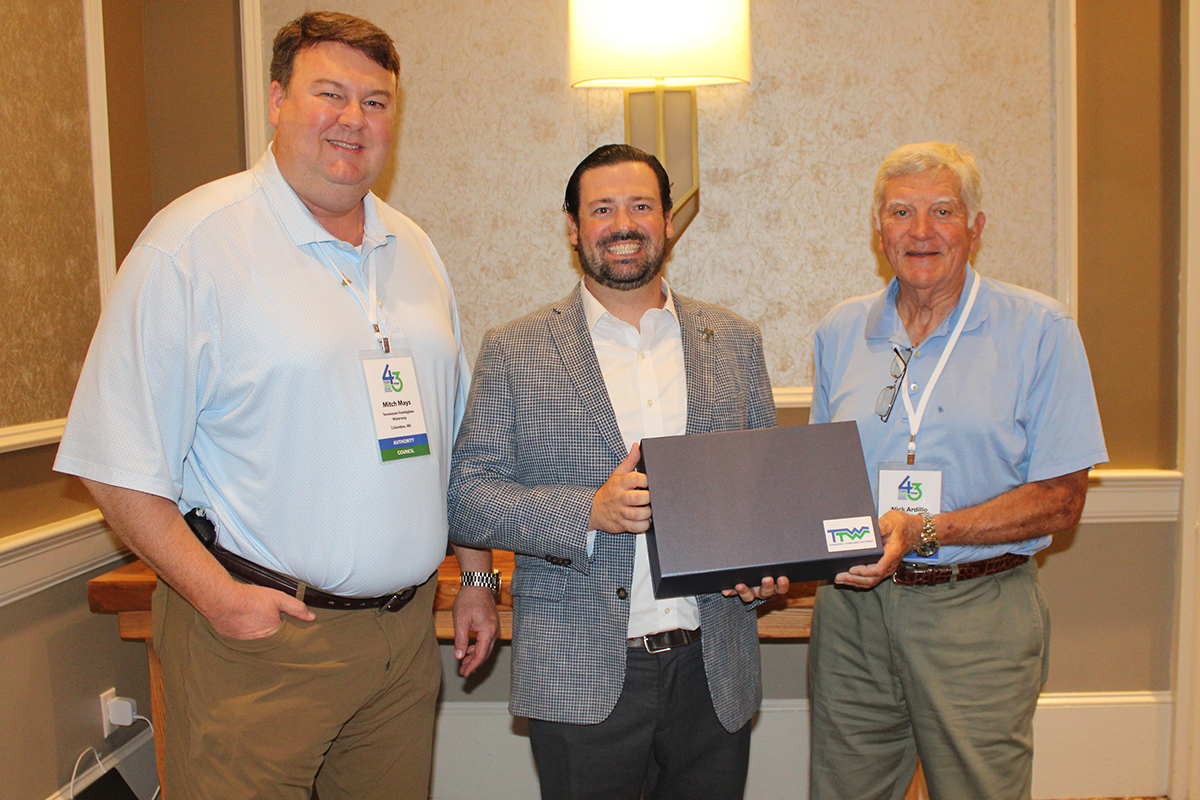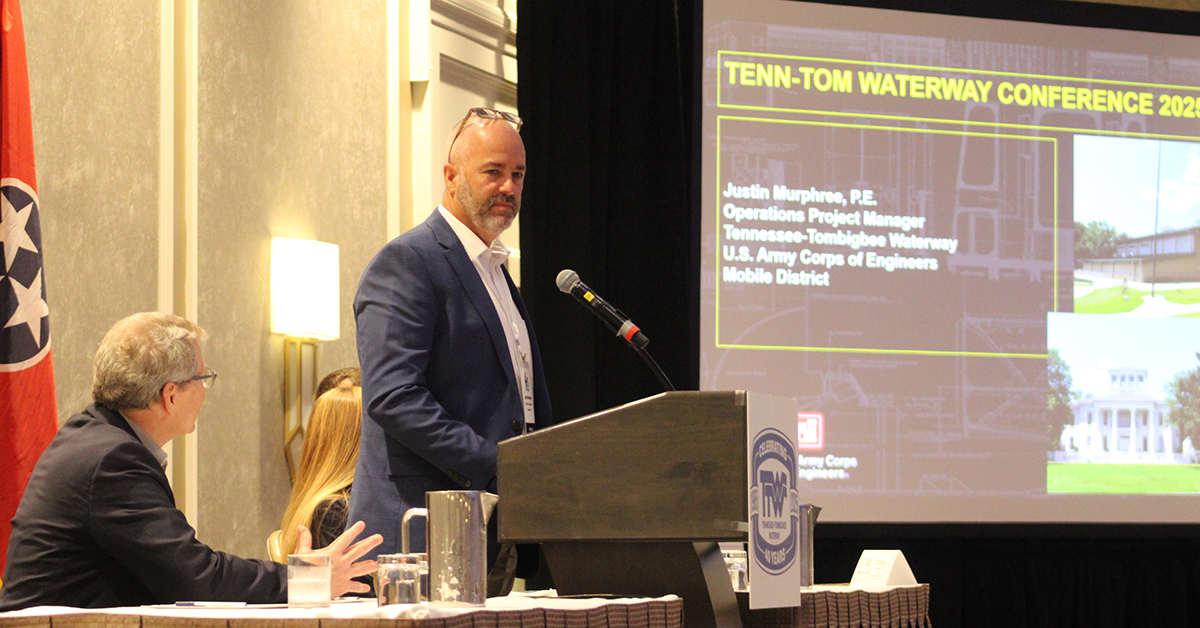Over the past year, the Tennessee-Tombigbee Waterway has marked a number of 40th anniversary milestones. On December 12, 1984, Corps of Engineers contractors removed the last section of earth separating the upper canal portion of the waterway and the Tombigbee River. January 14 of this year marked 40 years since the mv. Eddie Waxler left Mobile, Ala., bound for the Tenn-Tom and, eventually, a refinery on the Tennessee River in Sheffield, Ala. The Eddie Waxler was the first commercial vessel to utilize the waterway.
Waterway stakeholders met in Point Clear, Ala., August 13–15 for the Tennessee-Tombigbee Waterway Development Authority’s 43rd annual conference. While the majority of the conference focused on current affairs and future development along the 234-mile waterway and wider region, a highlight of the gathering came the evening of August 14 when Don Waldon, the Tenn-Tom Waterway’s longtime administrator, discussed his new book, “Journey to the River: The Political and Engineering Challenges Endured to Build the Tennessee-Tombigbee Waterway.”
In a keynote address during the evening meal, Waldon recounted some of the challenges to constructing and completing the waterway. More than engineering challenges, the Tenn-Tom Waterway faced fierce legal opposition from environmental groups and political uncertainty in Congress and from several presidential administrations. Yet, through authority leaders, including Walden and Glover Wilkins, and with the backing of legislators like Sen. Howell Heflin (D-Ala.), John C. Stennis (D-Miss.), Rep. Jamie Whitten (D-Miss.) and others, the waterway was completed in late 1984 after about 12 years of construction.
The total cost of the waterway and its 10 locks and dams was just under $2 billion.
Waldon’s book includes plenty of autobiography, and he weaves together his story and that of the waterway. In 2014, recognizing the incredible impact Waldon had on the construction and operation of the Tenn-Tom, Congress designated that the lock at Amory, Miss., will eventually bear his name.
Speaking at the conference, Waldon said he wanted to write a history of the Tenn-Tom “because I was either present for much of it or knew those who were.”
“I lived it,” he said.
The crowd listened in tense silence as Waldon described watching from the gallery in the Capitol in Washington D.C. as congressional leaders debated funding the waterway and how he and his team helped craft language in a bill that secured enough support for that last stage of construction. At the end of his talk, those present honored Waldon with an extended standing ovation.

Throughout the conference, Waldon spent much of the time between sessions signing copies of his book. Proceeds from the sale of the book benefitted the Agnes Zaiontz Tennessee-Tombigbee Waterway Transportation Museum and Intermodal Learning Center.
Infrastructure Focus
Tracy Zea, president and CEO of Waterways Council Inc., addressed waterway stakeholders during day one of the conference with a wide-angle view of inland waterway infrastructure throughout the system. Zea opened by underscoring the significance of the waterways for commerce, pointing to coal and grain exports and petroleum products moved throughout the system. A key example is gasoline delivered to Nashville, Tenn.
“Ten years ago, less than 2 percent of gasoline was brought into Nashville by barge,” Zea said. “Last year, in 2024, it was 60 percent.”
The problem, though, arises from the age of locks and dams throughout the country. Eighty percent of the nation’s locks are past their 50-year design life. At the same time, new construction projects are taking decades to complete. Zea was blunt with his assessment.
“If things don’t change, we’re all going to have to come together for a solution,” he said.
Inflation and labor challenges have driven up the cost of lock projects, such that the Corps of Engineers’ most recent Capital Investment Strategy says no more than two projects can be under construction at a time. Still, the rising cost of projects poses a huge challenge. Zea pointed to the Inner Harbor Navigation Canal Lock Replacement project, which is estimated to cost $4.68 billion. The Corps estimates the lock could come online in 2047.
“If that’s the new cost of locks, then we’re not building any more locks in this country,” Zea said.

Justin Murphree, operations project manager for the Tennessee-Tombigbee Waterway, outlined upcoming work during day two of the conference. Jamie Whitten Lock, located near New Site, Miss., and just north of where the Natchez Trace Parkway crosses the waterway, is in the midst of a month-long closure for routine maintenance, hydraulic piping replacement, lower gate repairs and culvert ceiling repairs. Closures are scheduled for Thad Cochran Lock and Glover Wilkins Lock in fiscal year 2026.
On the nearby Black Warrior-Tombigbee Waterway, permanent repairs to a monolith at Holt Lock will commence in November. During the work, the lock will be closed for construction Monday through Friday, with the lock open to navigation Saturdays and Sundays.
Mike Steenhoek, executive director of the Soy Transportation Coalition, discussed the impact of the deepening of the Mississippi River Ship Channel to 50 feet on Midwest farmers. The deepening on the lower river made moving grains by barge more cost effective. Steenhoek applied that investment approach to projects throughout the system, including building out the country’s trade schools. All of that makes the United States more competitive against other countries.
To round out the conference, attendees heard an update from Enviva Biomass, which operates a wood pulp export terminal in the Port of Pascagoula, Miss., and is building a new pellet mill in Epes, Ala., on the Tenn-Tom. Maggie Oliver, vice president of communications for the Alabama Port Authority, discussed the Mobile Harbor expansion project, which is nearing completion. Dan Caughran, vice president of production operations for United Launch Alliance, discussed the impact the closure of the main chamber at Wilson Lock on the Tennessee River in Florence, Ala., had on the movement of rocket components from Decatur, Ala., to either Cape Canaveral, Fla., or the West Coast.
The dates of next year’s Tennessee-Tombigbee Waterway Conference are already set. The event again will be held at the Grand Hotel Marriott in Point Clear, Ala., August 12–14, 2026.
Featured image caption: Vern Gwin (left), chief of operations for the Mobile District, looks on as Justin Murphree, the operations project manager for the Tenn-Tom Waterway, offers an update on the waterway at the annual Tennessee-Tombigbee Waterway Conference. (Photo courtesy of the Tennessee-Tombigbee Waterway Development Authority)



